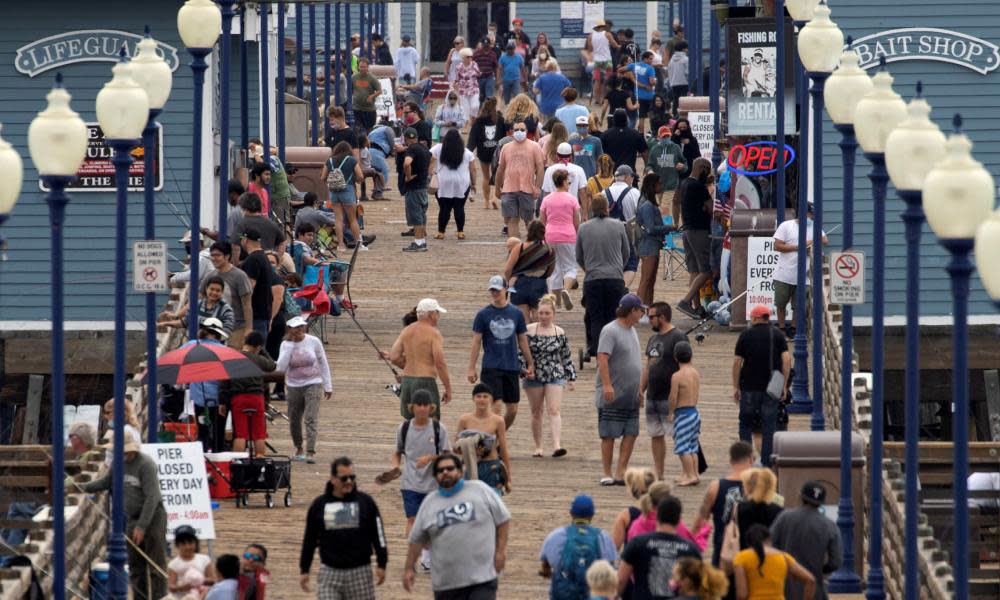California urges people to wear masks amid record Covid-19 hospitalizations

California officials implored residents to wear face masks and keep their distance from each other, after a record number of people were hospitalized with coronavirus over the weekend.
The state has reported more than 5,500 deaths and more than 178,000 cases, with more than 3,700 hospitalized on Sunday, surpassing the previous record of 3,547 hospitalizations set at the end of April. Health officials warned that while the spread of disease seems to have stabilized in many parts of the state, metrics in some rural regions of southern and central California are cause for concern.
California is seeing a surge in new cases as malls, museums, movie theaters and other public gathering-spaces reopened across the state, with 46,735 Californian testing positive for Covid-19 over the past two weeks. That number represents more than a third of all known cases since March, the governor, Gavin Newsom, said in a press conference on Monday.
Related: Half of US states see coronavirus surge as officials warn first wave far from over
Increased testing can only partly explain the huge increase, he added. “Those that suggest that we’re out of the woods, those that say this is just going to disappear – these numbers tell a very, very different and sobering story,” he said.
Newsom issued an order requiring nearly all Californians to wear masks in public last week, but the policy has met resistance in some parts of the state. In some of the counties where cases and hospitalizations have swelled, local officials have scaled back requirements to wear face masks in public amid rebellion. In Fresno county, a face mask rule was in place for a day before it was pulled back. In Riverside and San Bernardino counties, officials have flagged an increase in social gatherings as one of the main reasons cases and hospitalizations are rising. Both counties eased mask-wearing rules after public outcry.
In Orange county, the top health officer resigned after being harassed and receiving death threats over her countywide face mask order. Her replacement rescinded the order after pressure from the local board of supervisors.
“It really hasn’t helped that you’ve had some of these groups thinking that wearing a face mask is the first step in tyranny or communism,” said David Hayes-Bautista, an epidemiologist at the University of California, Los Angeles.
As Donald Trump and rightwing politicians and media outlets derided masks as unnecessary, Newsom enlisted four former governors to help spread the message that “no matter who you voted for, or if you didn’t vote at all”, wearing masks can save lives. The former Republican governor and bodybuilder Arnold Schwarzenegger implicitly pushed back against rightwing sentiment by emphasizing: “This is not about being weak.”
“We know that masks are an effective way to prevent infections,” said Kirsten Bibbins-Domingo, a physician and epidemiologist at the University of California, San Francisco. “I’m concerned that when we can’t get very simple messages about mask-wearing out to the entire population, it’s our poor and marginalized communities that will end up bearing the brunt.”
Across the state, Latinx patients account for 57% of all coronavirus cases, despite comprising just 39% of the population. A study in San Francisco’s Mission district found that amid the shelter-in-place restrictions in April, only 2% of the neighborhood contracted Covid-19, but that the vast majority who did were Latinx and unable to work from home.
Statewide, a large proportion of frontline workers at grocery stores, restaurants, farms, meat-packing plants and construction sites are Latinx “and working to keep our environment safe and clean”, Bibbins-Domingo said. As communities ease restrictions, going to a restaurant or a grocery store without a mask may be fine for the customer who spends a few minutes or hours outside without protection. But for workers at the restaurants and stores who are exposed to many people without masks, “that can really put them at risk,” she noted.
While the proportion of people testing positive in California remains below the World Health Organization’s threshold of 5% for safely reopening, the figure has slowly crept up in the past week – from 4.5% to 4.8%.
Outbreaks at homeless shelters, nursing homes and prisons have also contributed to increases in cases, officials said. Outbreaks that left a quarter of inmates infected at Avenal state prison and the California Institution for Men in Chino – both in southern California – have killed 17 inmates and have spread through staff into surrounding areas.
Related: San Quentin: outcry after Covid-19 cases at California prison triple in two weeks
Still, the number of hospitalizations and ICU admissions have remained relatively stable, inching up by about 1% over the past week. The records don’t currently show a surge following weeks of protests against police brutality, probably because the demonstrations took place outside – where the virus is less likely to spread – and many protesters wore masks, health experts said.
While the state remains on track to finish training more than 10,000 contact tracers by July to help catch and curb any eruptions of cases, “contact tracing is only as robust and good and successful as we have the ability to allow people … to be able to isolate safely at home,” the health secretary, Mark Ghaly, said at the briefing on Monday.
Those who cannot afford to stay home and those who don’t have access to safe or stable shelter are most vulnerable to a pandemic that “has really shined x-ray of the inequalities in American society”, Hayes-Bautista noted. As the unequal toll of coronavirus on Black and Brown people becomes increasingly clear, officials have yet to “address all the structural situations behind that inequality”, he said.

